Content marketing is here to stay. A significant percentage of businesses agree content marketing has the highest ROI of all their marketing efforts. Plus, a huge 83% say it’s their most effective demand generation strategy:
Any business that wants to boost their marketing ROI and convert more leads has to develop a stellar content marketing strategy. Unfortunately, that means more than simply posting on Instagram every day and cramming your blog with AI-generated articles.
Content marketing is an art form of its own. Getting it right takes time, dedication, and a whole load of trial-and-error.
However, there are things you can do right now that will increase your chances of hitting the ground running. Looking for easy tips for effective content marketing? Today, we’re letting you in on 15+ effective content marketing tactics tried and tested by our in-house digital marketing experts. No more guesswork, no more wasted marketing spend. Just clear, proven content marketing strategies you can start working on today!
What Makes Content Marketing Effective?
Before we reveal our easy tips for effective content marketing, we need to understand exactly what makes for effective content marketing:
A Clear Link Between Content and Business Goals
We see far too many content strategies that simply don’t match business goals. Or, they have the vague goal of “getting attention”, which is as good as having no goal whatsoever.
Directionless content always underperforms. As it costs money to produce content, this can quickly end up draining your marketing budget without seeing the results you need
Content has to lead to real revenue, not just reach. It’s all very well gaining 10 new leads, but if the content doesn’t direct them to an action (say, signing up for a demo) with irresistible CTAs, then it’s effectively useless.
The best strategy is to use goals to reverse-engineer your content. Let’s say you want to get leads to sign up to a demo. What’s the best way to show off your software? Well, video is the best-performing content marketing format, and it’s a great way to display your service, so why not make a demo video for your mailing list?
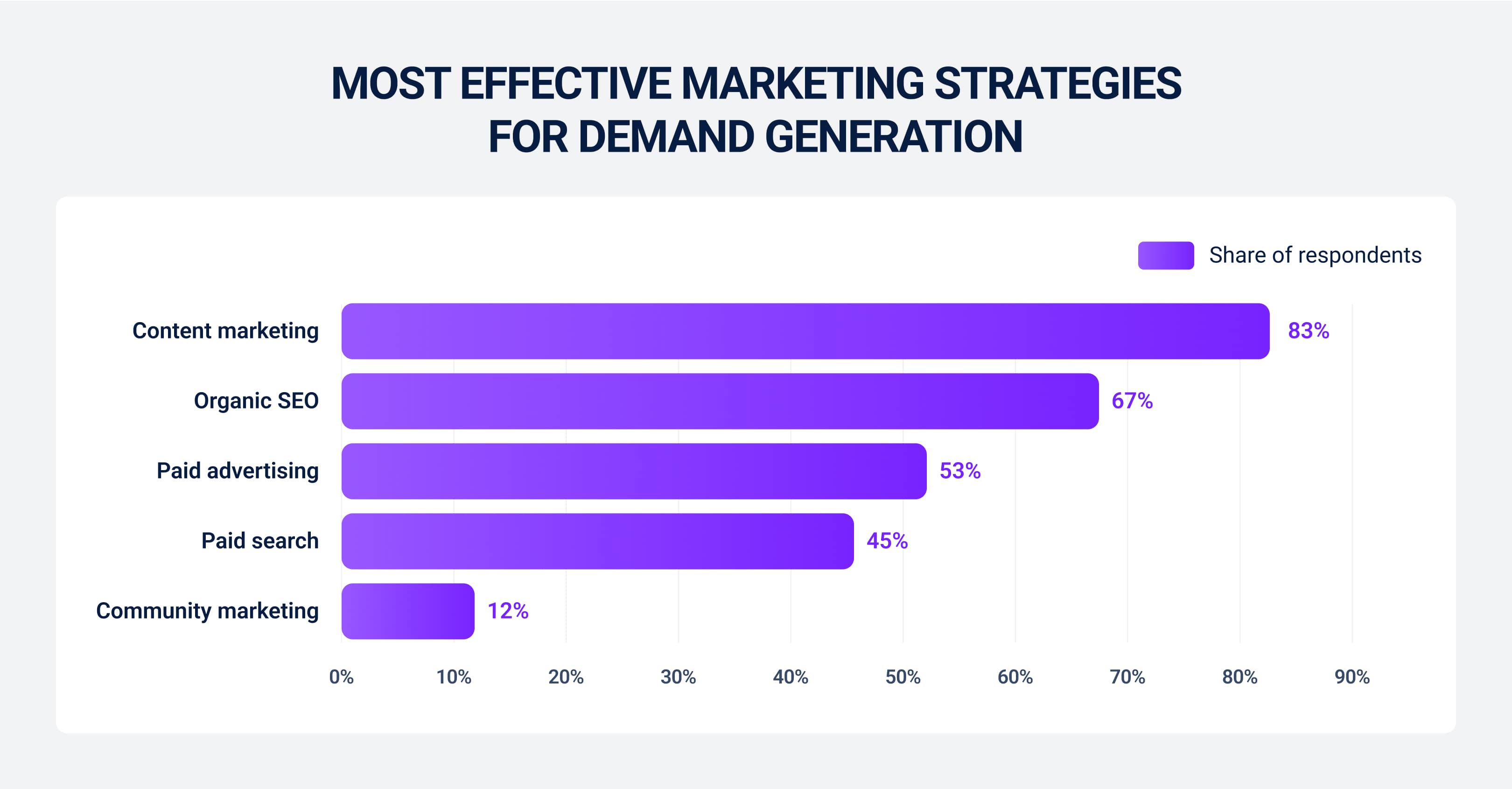
A Focus on Buyer Intent and Content Purpose
Not all content is the same. Effective content is tailored to a specific funnel stage. In other words, is your content designed to make people aware of your brand, teach them about your brand and compare it to competitors, or to convert them?
This is where different types of content come in:
- Educational content - targeting “informational searches” by providing authoritative and trustworthy blog posts, for instance.
- Product-led content - content that directly calls out your product/service as a solution to a problem. This is perfect for leads in the “consideration” stage of the funnel.
- Retention content - designed solely to retain existing customers and keep them excited (would usually be distributed through email, for instance).
Remember: content that fulfils its objective effectively is far better than content that gets a lot of clicks but doesn’t lead anywhere!
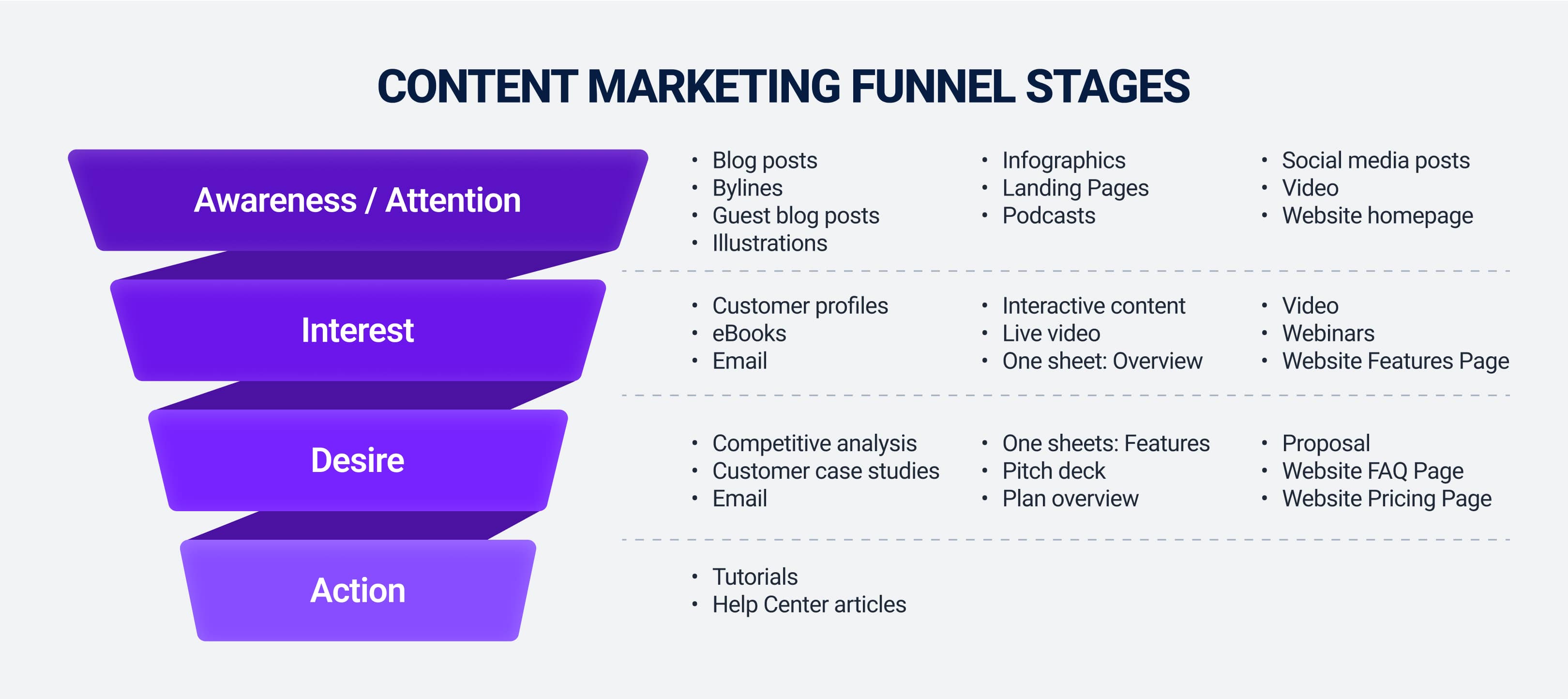
Distribution That Matches Format and Audience
Think about how you’re getting your content “out there”. It’s not always enough to simply post it and leave it. Sometimes, you have to go the extra mile to make it effective.
The key thing is to use content and platforms that fit your customers’ behavior. Targeting B2B salespeople? Use LinkedIn. Advertising a product to Gen Z? Use TikTok videos/Instagram Reels.
It’s not all about social media (even though it’s the most effective content marketing channel). Don’t neglect email marketing and SEO, for example.
That brings us onto another consideration: paid vs. organic amplification of content.
- Paid - the business buys ads that target specific lead types in specific places.
- Organic - the business relies on SEO to draw leads in without ads.
Most businesses use a combination of both paid and organic content.
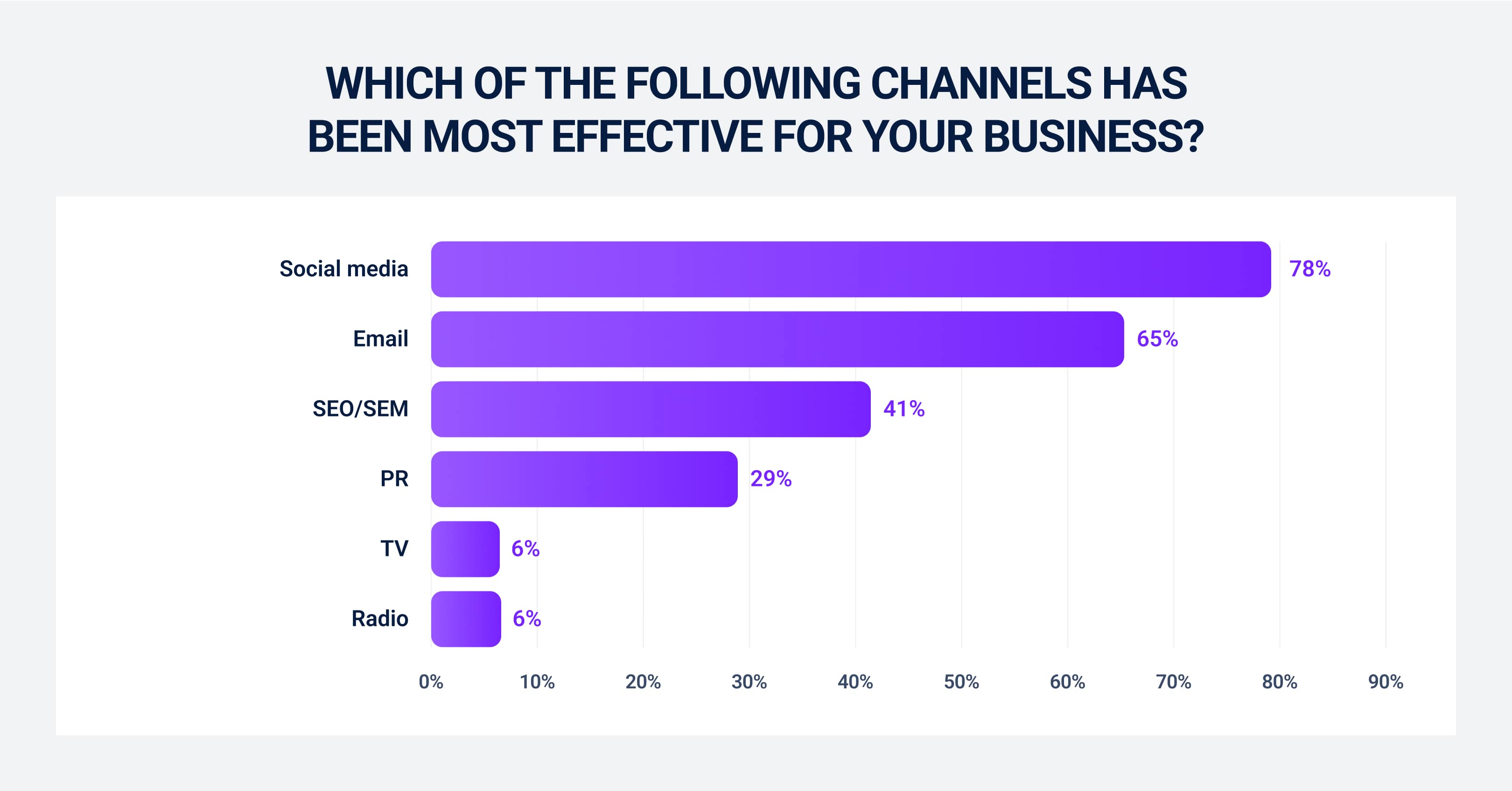
Quick Wins That Improve Content Marketing Fast
Still struggling to see content marketing ROI? It doesn’t have to be hard if you know what you’re doing. Try these effective content marketing tactics from our experts:
Develop a Consistent Brand Voice Across All Platforms
All serious marketers agree that brand voice is absolutely central to effective marketing. Not only developing a distinctive brand voice, but also using that voice consistently across different channels, is key to building brand loyalty and recognition.
You may not notice it, but big brands work very hard on their brand voice. Take a few big names and see what comes to mind:
- Nike - bold, inspiring, motivational.
- Innocent Drinks - friendly, cheeky, simple.
- Dove - empathetic, authentic.
These are these companies’ brand voices. Here are some top tips for getting yours right:
Create a Content Calendar to Streamline Planning
Never ad-lib content marketing. You’ll end up with inconsistent results. A content calendar is your best friend.
Don’t just write down the dates you want to post, however. Make your calendar detailed and comprehensive. Make an Excel or Google Sheets spreadsheet that includes columns for:
- Date and Time
- Platform
- Content Type
- Content Title/Topic
- Content Brief/Outline
- Call to Action
- Target Keywords
- Status (e.g., Idea, In Progress, Published)
- Assigned Team Member
Lots of CRMs and dedicated content calendar tools help out with this and reduce the amount of manual work you have to do. Our favorite is Co Schedule.
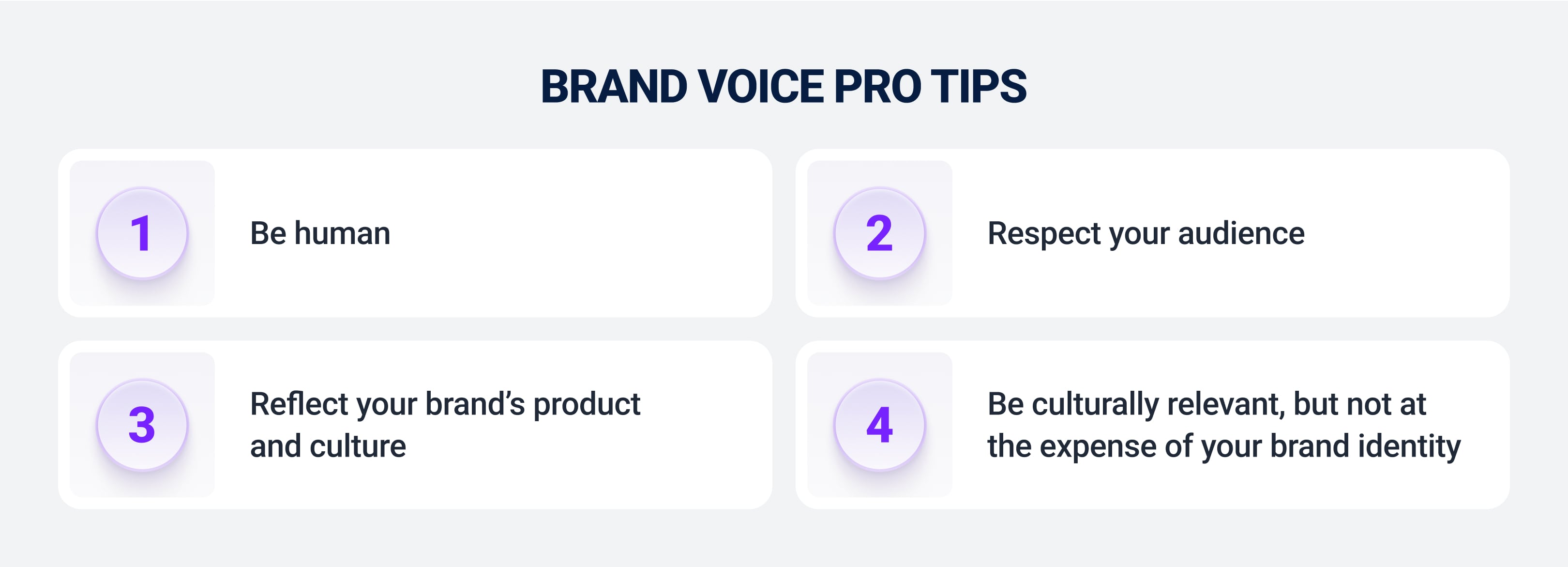
Use Storytelling to Make Content More Relatable
Storytelling helps humanize your brand and can foster a connection between you and your audience. But there’s a tangible result, too:
Jerome Bruner supposedly proved that people are 22x more likely to remember stories than facts alone, and more recent studies do indeed show that most people’s memories favor stories. For content marketers, that’s incentive enough to make your content more compelling and memorable by exploiting people’s natural preference for stories.
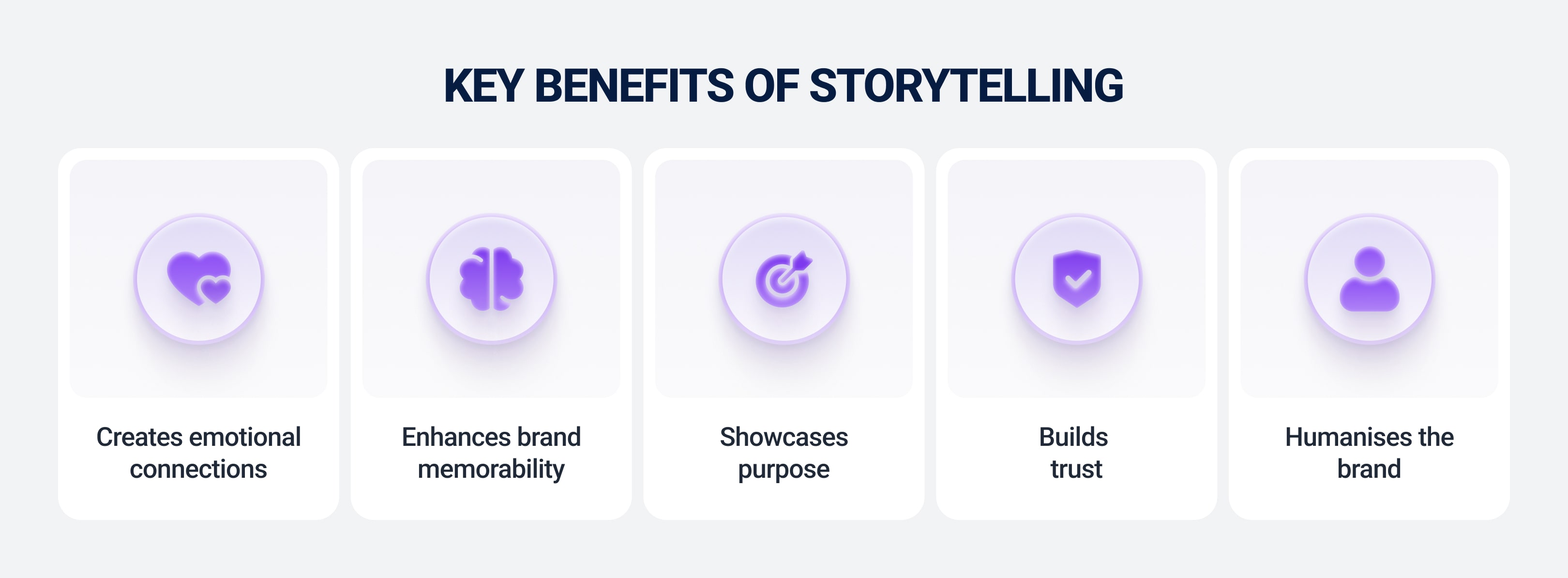
Leverage User Feedback to Shape Content Direction
Your audience, the ones actually consuming your content, are the best authority on how effective it is. It's a great idea to use surveys and even check comments on social media to see how people are reacting to your content.
You can use this feedback to:
- Identify content gaps
- Refine messaging for more impact
- Prioritize topics that matter most
Continuously gathering and applying user input helps ensure your content remains relevant and engaging to audiences.
Increase Content Interactivity With Polls and Quizzes
Interactive content beats static content in almost every metric. More clicks, higher retention, more conversions - in fact, interactive content generates twice as many conversions as static equivalent content and most B2B buyers claim to prefer it.
It follows that any content marketer should consider interactivity as a serious method for engagement. Polls and quizzes, for example, are excellent tools for:
- Gathering opinions
- Educating your audience
- Adding fun to your content
Collaborate With Industry Experts for Guest Content
Partnering with respected experts in your field actually serves two purposes:
Firstly, bringing them into the fold for guest posts or interviews can expose your brand to new audiences and build powerful new relationships. That’s a fantastic opportunity to build brand awareness.
Secondly, it also helps boost your authority. As “authoritativeness” is one of Google’s E-E-A-T ranking principles, any extra authority you can bring increases your score, which helps you rank higher!
Repurpose High-Performing Content Into Different Formats
You don’t need to come up with a brand new idea every single time you publish/distribute a piece of content. You can massively speed up your content marketing process, plus increase your ROI tenfold, by repurposing a successful piece into multiple assets.
Repurposing means taking, say, a blog post, and turning its content into other formats, like a video, an infographic, a social media post, or even a podcast. The possibilities are endless.
However, it’s important to reformat, too. Adapt your content so that it fits its new channel. Focus on evergreen content with consistent performance to extend its lifecycle and reinforce your core messages in diverse ways.
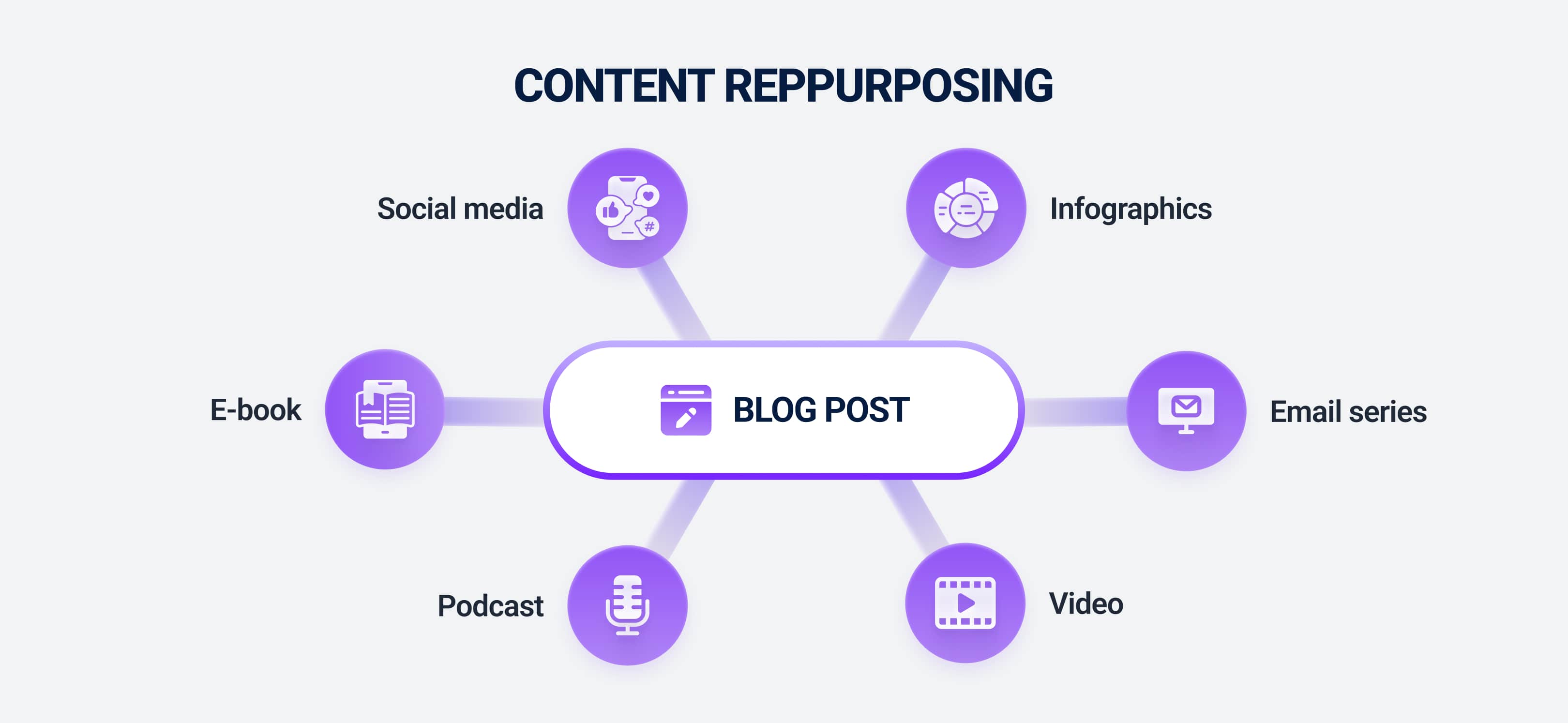
Use Data-Driven Insights to Guide Content Creation
It’s better to trust and rely on your data than your gut to direct your marketing efforts.
Analytics tools can reveal exactly which topics, formats, and channels drive the most engagement, as well as which trends are up-and-coming. Data-driven decisions lead to more targeted, effective content that better meets audience expectations and business goals.
Focus On Visual Content Like Videos and Infographics
We found that our own content shows that over 90% of our consumers prefer visual content over written text. That can’t just be blamed on screens; it’s partly down to biology, too. Your brain actually processes visuals 60,000x faster than words!
That’s clear in the marketing KPIs, too. Visuals increase retention and drive more engagement than text alone. Videos explain complex ideas quickly, while infographics present data in an appealing, digestible format.
Use visuals to complement your written content, especially on platforms like Instagram, YouTube, or LinkedIn, where visual storytelling thrives.
Share Behind-The-Scenes Content to Build Authenticity
People love to see “behind the curtain”. Humanize your brand by giving glimpses of your team and their creative process, or even just your “day-to-day”. It doesn’t have to sell anything. You can just use behind-the-scenes content to build trust and transparency.
Here are some BTS ideas to get you started:
- Meet the team
- Workspace tour
- Day-to-day workflows
- Tease an upcoming launch
- “Making of” videos
The eyewear company Warby Parker does this really well with fun BTS videos:
Post User-Generated Content to Foster Community
People trust other customers more than they trust brands themselves. Your marketing team can use that. Encourage followers to share their experiences with your product or brand, then spotlight their content.
User-generated content (UGC) acts as authentic social proof and fosters a sense of community. Reposting UGC on your platforms also shows appreciation and encourages continued engagement!
Curate Industry News to Position Your Brand as an Expert
Trust is everything in marketing, and building authority as an expert is one of the best ways to build long-term trust. Over 80% of consumers won’t even consider buying from a brand unless they trust them.
You want to show you’re informed and engaged with industry trends, so start by simply sharing and curating timely, relevant news. From there, you can add insightful commentary and your unique perspective to set your voice apart and encourage followers to rely on your updates.
GROW YOUR INSTAGRAM FOLLOWING VIA OUR CELEBRITY CAMPAIGNS
Leverage the power of the worlds A-list celebrities to grow your Instagram every month
VIEW CAMPAIGNSLaunch Limited-Time Content Offers to Create Urgency
Content doesn’t have to be evergreen with steady, long-term ROI. Why not explore “shooting star” style content, too?
By this, we mean exclusive, time-sensitive content such as:
- Downloadable guides packed with info
- Valuable webinars with experts
- Limited-time discount codes
Limited-time offers encourage immediate action and can drive traffic spikes. Promote these offers through email and social media to maximize reach and engagement within the set timeframe.

Test Content Formats (e.g., Long-Form vs. Short-Form)
It’s a common belief that short-form content always outperforms long-form. However, the truth is that different audiences prefer different formats. Likewise, different topics demand different formats.
Why not test long-form blog posts, short videos, listicles, and carousels to see what resonates best? Track engagement metrics like time on page and bounce rates to refine your approach and optimize content length and style accordingly.
Encourage Content Sharing With Compelling Calls to Action
A great call-to-action can dramatically increase conversion rates. A lot of conversions could be thrown away simply by having a weak CTA.
To start with, all content should always have some kind of CTA. It doesn’t have to be, “buy now”. It can be as gentle as, “what do you think? Comment below!” The key thing is that there should always be a desired action.
Also consider A/B testing different CTAs and figuring out what approach works best with your audience. Professional marketers can spend years mastering the art of the CTA!
How to Measure Content Marketing ROI
Content marketing requires specific ROI metrics to see how well your content is performing. However, it’s not just about conversion rate:
- Define your goals - the first step is to determine what exactly you want your content to achieve. It could be conversions, but it could also be brand awareness (harder to quantify) or engagement, for example. This will determine which metrics you measure.
- Track key metrics - the metrics you monitor should reflect your content goals. For example, for web traffic, measure unique visitors, for leads, form submissions and email signups. If you’re going for sales, you might want to watch revenue instead.
- Assign monetary value - figure out how much dollar value each outcome brings. For example, determine the average value of a lead or the customer lifetime value (CLV).
- Calculate costs - to determine ROI, you also need to know the “I” (the investment). Remember to include all content-related costs, like:
- Content creation (writers, designers, video editors)
- Promotion (ads, influencer fees)
- Tools and software (CMS, analytics tools)
- Team time and overhead
- Use the ROI formula - use “content ROI = Revenue from Content - Cost of Content / Cost of Content”. For instance, if you generated $10,000 from content marketing and spent $2,500, your ROI would be 300%.
Mistakes That Make Content Marketing Ineffective
Look out for these common content marketing challenges that can turn effective content marketing tactics into non-starters:
Focusing Too Much on Quantity Over Quality
Consistency is paramount. But consistency doesn’t mean quantity. Pumping out large volumes of content, especially AI content marketing content with no oversight, without ensuring it's valuable can dilute your brand and overwhelm your audience.
It’s far more effective to focus on high-quality content that:
- Educates
- Entertains
- Solves a problem
This type of content is far more likely to drive engagement and build trust.
Ignoring Audience Intent and Needs
Content that doesn’t address what your audience truly wants equals low engagement. Even if you think your content reflects your brand and has some value, your audience might not agree. Remember, your audience is the ultimate arbiter of good and bad content.
We recommend:
- Conducting audience research
- Focusing on keyword intent
- Tailor messaging through feedback
When content aligns with user interests and goals, it's more likely to convert and foster long-term loyalty.
Overlooking SEO
It doesn’t matter how great your content itself is if no one can find it. Neglecting on-page SEO can seriously limit your visibility. Consider optimizing your:
- Keywords
- Meta descriptions
- Headers
- Alt tags
It’s also a good idea to integrate SEO strategy right from the very beginning. Use it in the planning stage to make sure your content gets discovered organically.
Another tip is to use AI. AI SEO tools have been proven to improve SEO results for 6 out of 10 marketers! AI is now a must and is why as an agency we have integrated AI tools into our workflow at every available opportunity. Just make sure you’re not keyword stuffing, as this can push your content down SERPs.
Neglecting Consistency in Publishing
People lose interest when you post irregularly. This can seriously damage your credibility. We recommend building a consistent publishing schedule ahead of time to help build anticipation and reinforce your presence.
You could consider:
- Weekly blog posts
- Daily social media updates
- Monthly newsletters
Whatever it is, this content rhythm keeps your audience engaged and your brand top-of-mind.
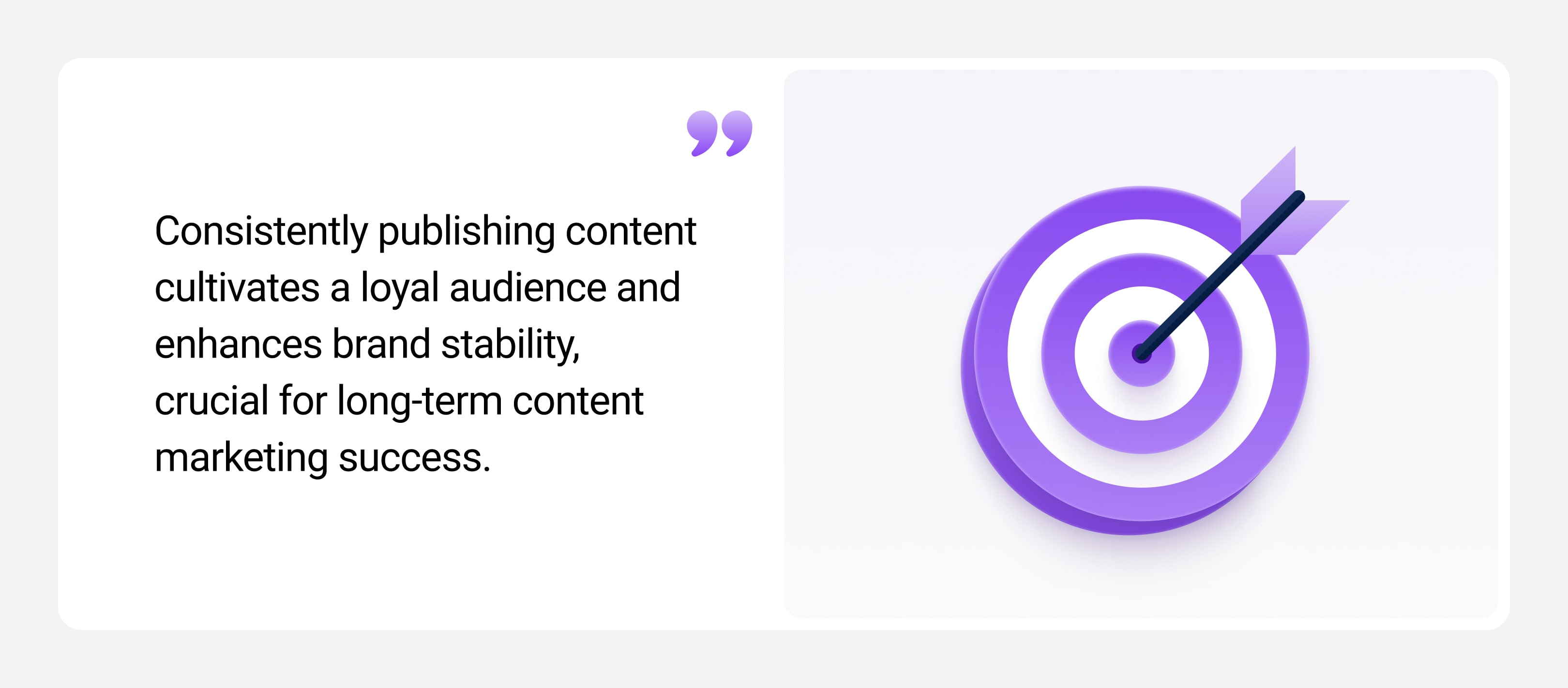
Failing to Measure Performance
Never guess what works. If you don’t track your KPIs, how are you supposed to know where to focus your marketing efforts (and budget)?
Unfortunately, too many small businesses fail to properly analyze content data like traffic or engagement. Even if they think they’re doing so, they might not be going deep enough. Counting likes, for example, isn’t enough to determine engagement. You have to see who’s liking (are they bots?) and when/why.
Use tools like Google Analytics or HubSpot to assess ROI and refine your strategy based on actual results.
Not Promoting Content Effectively
Publishing killer content is just the start of the journey. There’s a lot of content out there and you need yours to get noticed. How?
Promotion. Think about ways you could get your content in front of high-potential leads, such as:
- Email marketing
- Social media
- Influencer collaborations
- Paid ads
Nail distribution and guarantee your message reaches the right people at the right time.
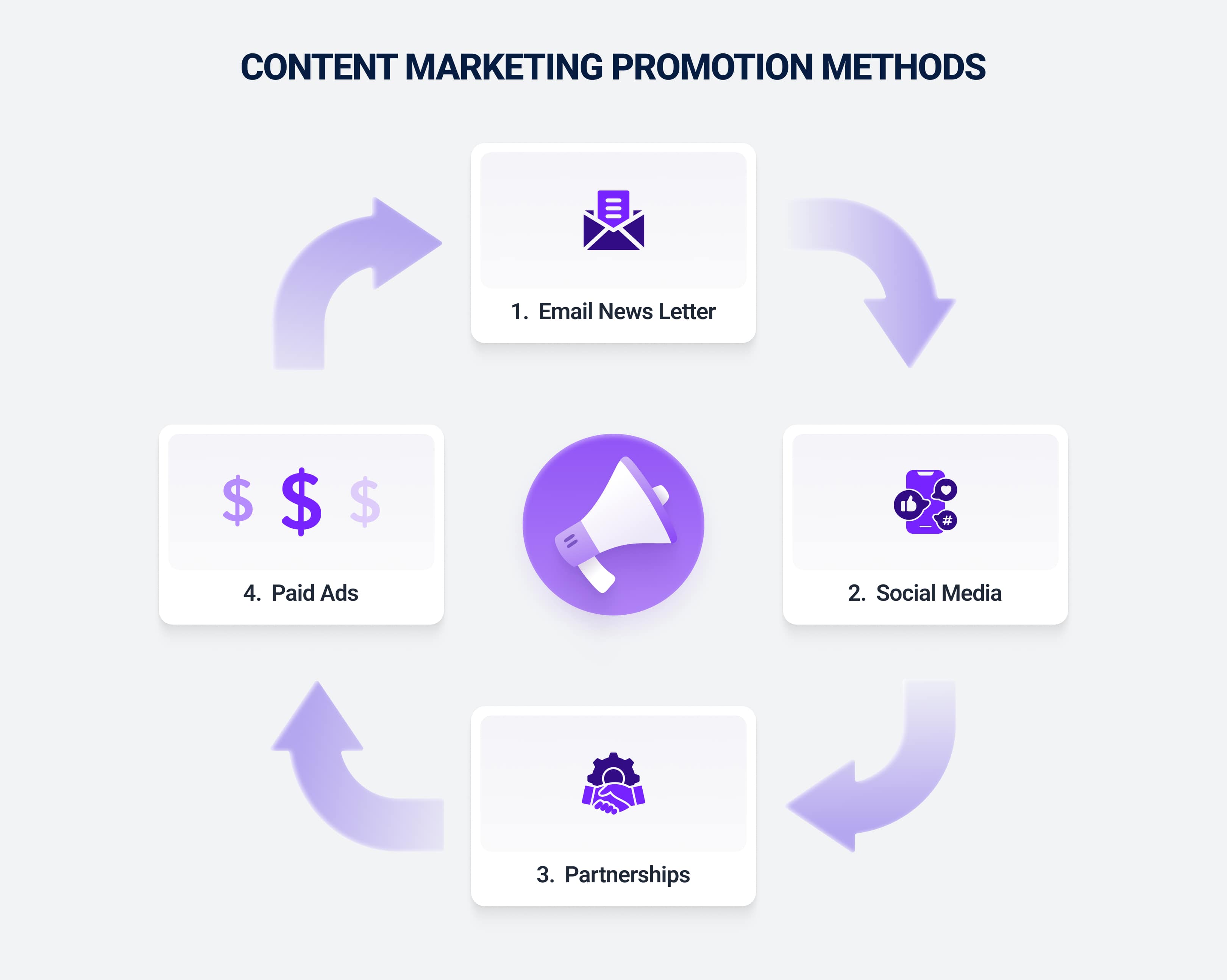
Using Overly Promotional Language
Content marketing should always be about providing value and building trust. The fastest way to destroy that is to label something “educational” and slap the audience with a blatant sales pitch.
Always avoid phrases like:
- “Buy now!”
- “Hurry!”
- “Don’t miss out”
- “Click here”
- “Guaranteed results”
- “One-time offer”
- “Selling fast!”
See how these words put you off? Assume your audience knows what you’re trying to do. Instead, focus on providing engaging and informative content which naturally leads to conversions.
Lacking a Clear Call to Action
Audiences may consume your content and even really like it, but without a CTA, they’ll simply move on. The goal of every piece of content should be to guide the audience to perform an action.
That could be as simple as sharing the post or as big as reaching out for a demo. Either way, guide your readers/viewers with simple, actionable CTAs.
Here are some CTA tips to bear in mind:

Expert Content Marketing Wins for New Brands
Outstanding content marketing strategy examples and success stories are all around us. Thousands of big brands have used content marketing tactics to transform their bottom lines.
Here are some notable examples to learn from:
- HubSpot - HubSpot was actually one of the main pioneers of “inbound marketing” (which is effectively content marketing). They built their entire brand identity around offering free, high-quality educational content like blog posts and eBooks for marketers. Today, HubSpot has millions of users and takes in over $2 billion in revenue every year!
- Glossier - beauty brand Glossier’s “Into The Gloss” blog was their initial content hub. But since then, they’ve gone on to incorporate user-generated content by encouraging customers to share real photos and reviews with incredible expertise. Thanks to their marketing efforts, Glossier has a market value of around $1.8 billion.
- Blendtec - this campaign is perhaps the oldest in the list, but still holds up for its pure entertainment value. The blender brand Blendtec created a series of humorous videos blending unusual items (like iPhones) to showcase the power of their blenders. It worked. Almost 20 years later, we’re still talking about it. The campaign supposedly increased sales by 700%!
The Bottom Line
There was a time when content marketing was an unknown term, a trendy marketing tactic that was yet to prove itself. In 2025, it’s done more than that. Content marketing is now the preferred marketing technique for brands across most industries. High-quality, engaging content that doesn’t directly “sell something” can actually generate more revenue than ads.
But how much revenue? It’s hard to give an exact number, but B2B content marketing is known to deliver a strong return on investment over time.
However, to see worthwhile ROI, content marketers need to get a few things right while sidestepping some common pitfalls. To summarize:
- Make sure the content itself is of high quality. It should be educational, entertaining, informative, helpful, and insightful, never salesy.
- Stay organized. Use a content calendar and adapt content to its channel requirements.
- Track and measure success with key metrics and be prepared to make changes when things aren’t going to plan.
That’s a lot to get right. If they’re not careful, some businesses can end up overspending on content marketing without seeing the results. That’s why we see over 50% of B2B businesses are outsourcing their content marketing to digital marketing agencies like Influize.
You don’t have to perfect the art of content marketing alone. Hiring Influize gives you immediate access to tailored content marketing strategies created and implemented by experienced professionals, and often at a lower cost than building an in-house team.
Frequently Asked Questions
How often should I update underperforming content?
You should at least review your content every 3-6 months. Look for alarm bells like declining traffic and high bounce rates, then figure out why. It could be that the information is simply outdated. If updates don’t yield results after a few cycles, consider repurposing or retiring the piece.
Can short-form content drive real business results?
Absolutely, especially when designed for mobile-first and fast-scrolling audiences. Content like Reels and TikToks, and even short-from written content like email snippets, are a great way to grab a busy audience’s attention and deliver quick value. “Short-form” doesn’t have to mean “trivial”. You can still pack a punch!
How do I identify content gaps worth filling immediately?
Start with a content audit. Use a tool like Semrush to find high-search, low-competition keywords and questions your audience is asking. You should also look for pages that see traffic but don’t seem to convert. These approaches can give you clues about what you’re not quite delivering.
Is AI-generated content worth using for quick ROI?
AI tools are great for speeding up your content marketing process (creating drafts, ideation, SEO research, content calendars), but they should never be in full control. Google penalizes content that’s not helpful and not trustworthy/authoritative. AI content often falls short. Make sure humans are overseeing and guiding content automation.
What content types convert best in B2B vs. B2C?
B2B audiences want proof that your product/service delivers clear ROI, so content like whitepapers and case studies tend to perform well. B2C offers broader possibilities. Depending on your content goals, everything from short videos and testimonials to how-tos and user-generated content see high conversion rates.

